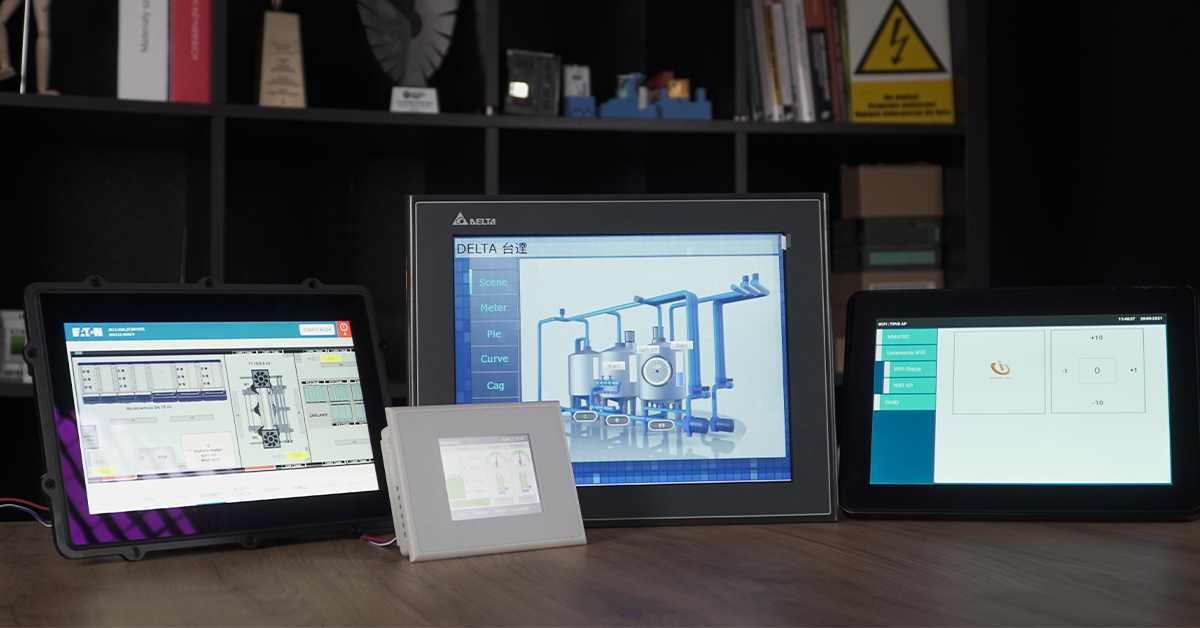Are you planning to introduce an HMI panel to your plant or are you considering replacing your current equipment? We know that you have an important decision ahead of you. Meanwhile, the number of distributors and offered panels can surpass all of us. So instead of comparing each parameter and browsing the catalogs in search of the “lesser evil” – choose wisely and optimally for your plant. Today we want to help you with this, see our advice on this matter.
Screen size
Consider what the screen size will be ergonomic for the operator. Of course, by choosing a smaller panel you will save money. Most of the currently produced touch matrices provide great accuracy, sensitivity and good resolution even at small sizes. If you do not have enough space to install a standard size panel, choose one that takes up the minimum space in the control cabinet. It can be a panel with an ultra-thin casing or a compact panel without a display, but with an HDMI input. A small screen may not be sufficient in some conditions. Imagine an operator who, wearing a thick glove, tries to hit a tiny object with his finger. If you need a large diagonal, but do not want to overpay, consider the following solutions:
- a panel with an HDMI output instead of a screen, for example: Weintek mTV or cMT-HDMI series, which you can place on a DIN rail, and you can attach a monitor, touch TV or a regular screen to it, as well as a mouse and keyboard,
- a panel enabling remote visualization, e.g. the cMT series allows for visualization on tablets, smartphones and computers thanks to a dedicated application.
Functionality
What do you need the panel for and how are you going to use it? As you can see, this is the basic issue that you must start with when looking for a panel that meets your needs. Currently, some panels are similar in functionality to SCADA systems, and in some applications even replace them. The most important functions that our new panel should have are:
- the ability to write scripts,
- data logging,
- creating recipes,
- alarms,
- creating user accounts,
- possibility of remote access,
- database support,
- schedules,
- support for various communication protocols,
- logging of operator activities,
- multi-language support,
- the ability to generate charts,
- PDF viewer,
- support for video formats, IP cameras.
And many, many other functionalities that will facilitate the work with the panel. It is worth remembering that, in addition to their flagship products, manufacturers have economical series that can cost a fraction of the price of the former. Of course, such a panel will work mainly in simple applications and therefore it will not be suitable when we need a real combine.
Rich graphic libraries
Not everyone has to be an artist. However, each project must be legible. Check if rich graphics libraries are available on your device. Thanks to them, you will quickly create an easy-to-use and eye-friendly visualization. It is worth using, for example, EasyBuilder Pro software – it has extensive system graphics libraries, recently refreshed and enriched with new elements.
Technical support and warranty
Technology is evolving at a dizzying pace. Both the software and the hardware itself change and update very often over the years. Your employees must not lag behind the advancement of new technologies in the age of Industry 4.0. It is very important that the company providing HMI and software guarantees technical support, reliable employee training and assistance in handling. An equally important issue is the warranty period itself, which covers the panel – check it before buying.
Remote access
If you want to connect to the HMI from any device and from anywhere, and in this way to control the operation of the plant, choose the panel with EasyAccess software. It enables a secure connection as well as remote maintenance and supervision even if the office is far away from the factory. The cMT Viewer application, installed on an Android device or on an iPad, allows you to monitor the status of machines located anywhere in the enterprise. It gives you immediate access to production data, events and alarms in real time.
Backwards compatibility
It is worth checking whether a given producer has the ability to convert projects from older versions of the software to newer ones. It is not worth reinventing the wheel.
Panel for special tasks
There are still issues that are usually forgotten when buying new equipment. They are not always relevant, that’s true. However, when the application requires specific conditions or the panel will work in a difficult environment, we must make sure:
- at what temperature and humidity will the panel work,
- what certificates does the panel have,
- will you be able to mount glass / protective film on the display,
- what is the power range,
- does the panel have PCB shell protection,
- what level of IP protection will be provided,
- whether the panel has power optocoupling,
- is it shockproof.
Start by thinking about the conditions in your factory and how the panel will be used on a daily basis. Think about the real benefits of using a given model you and your employees will obtain. Starting with these issues and following our advice, you will be able to choose the most optimal device tailored to your needs. If you do not want to go into technical details, choose a supplier from whom you will receive the support of experienced advisers. A distributor, with whom it is worth cooperating, will suggest the optimal solution for your plant and make the HMI implementation in the factory as easy as possible.
